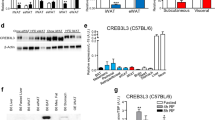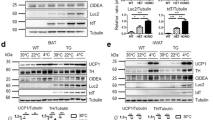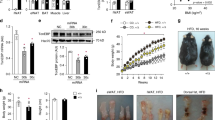Abstract
Background:
Cell death-inducing DFFA (DNA fragmentation factor-α)-like effector A (CIDEA) is a protein that regulates lipolysis in human adipocytes through cross-talk involving tumor necrosis factor-α (TNF-α). TNF-α downregulates CIDEA mRNA although it is unclear whether this is mediated through transcriptional or post-transcriptional mechanisms. CIDEA has important metabolic effects in human fat cells and genetic variations in the human CIDEA gene have been correlated to the development of obesity. However, little is known about the factors regulating CIDEA expression in human adipocytes. We set out to describe the transcriptional control of human CIDEA.
Methods:
A 1.1-kb genomic fragment upstream of the transcriptional start site (TSS) of human CIDEA was cloned and deletion fragments were generated. Transcriptional activity of the promoter was analyzed by luciferase reporter assays in in vitro-differentiated human adipocytes. The effect of TNF-α was assessed in human adipocytes and murine 3T3-L1 cells transfected with deletion fragments of the CIDEA promoter. Protein–DNA interactions were analyzed by electrophoretic mobility shift assays (EMSA).
Results:
Basal transcriptional activity was found in a 97-bp region upstream of the TSS. We studied the effect of three common haplotypes in the promoter region but found no significant difference in transcriptional activity among them. Incubation of in vitro-differentiated human adipocytes as well as 3T3-L1 cells with TNF-α reduced the transcriptional activity of the human CIDEA promoter, demonstrating a direct effect on CIDEA transcription. EMSAs and mutational analysis indicated that this was mediated by a nuclear factor-κB (NF-κB) site at position −163/−151.
Conclusion:
We demonstrate that basal transcription of the human CIDEA gene is confined to the 97 first bases upstream of TSS and that TNF-α negatively regulates transcription of this gene, which at least in part involves NF-κB activation.
This is a preview of subscription content, access via your institution
Access options
Subscribe to this journal
Receive 12 print issues and online access
$259.00 per year
only $21.58 per issue
Buy this article
- Purchase on Springer Link
- Instant access to full article PDF
Prices may be subject to local taxes which are calculated during checkout




Similar content being viewed by others
Accession codes
References
Kahn SE, Hull RL, Utzschneider KM . Mechanisms linking obesity to insulin resistance and type 2 diabetes. Nature 2006; 444: 840–846.
Van Gaal LF, Mertens IL, De Block CE . Mechanisms linking obesity with cardiovascular disease. Nature 2006; 444: 875–880.
Langin D, Arner P . Importance of TNFalpha and neutral lipases in human adipose tissue lipolysis. Trends Endocrinol Metab 2006; 17: 314–320.
Nordstrom EA, Ryden M, Backlund EC, Dahlman I, Kaaman M, Blomqvist L et al. A human-specific role of cell death-inducing DFFA (DNA fragmentation factor-alpha)-like effector A (CIDEA) in adipocyte lipolysis and obesity. Diabetes 2005; 54: 1726–1734.
Dahlman I, Linder K, Arvidsson Nordstrom E, Andersson I, Liden J, Verdich C et al. Changes in adipose tissue gene expression with energy-restricted diets in obese women. Am J Clin Nutr 2005; 81: 1275–1285.
Dahlman I, Kaaman M, Jiao H, Kere J, Laakso M, Arner P . The CIDEA gene V115F polymorphism is associated with obesity in Swedish subjects. Diabetes 2005; 54: 3032–3034.
Viswakarma N, Yu S, Naik S, Kashireddy P, Matsumoto K, Sarkar J et al. Transcriptional regulation of Cidea, mitochondrial cell death-inducing DNA fragmentation factor alpha-like effector A, in mouse liver by peroxisome proliferator-activated receptor alpha and gamma. J Biol Chem 2007; 282: 18613–18624.
Dicker A, Le Blanc K, Astrom G, van Harmelen V, Gotherstrom C, Blomqvist L et al. Functional studies of mesenchymal stem cells derived from adult human adipose tissue. Exp Cell Res 2005; 308: 283–290.
van Harmelen V, Skurk T, Hauner H . Primary culture and differentiation of human adipocyte precursor cells. Methods Mol Med 2005; 107: 125–135.
Shimizu M, Blaak EE, Lonnqvist F, Gafvels ME, Arner P . Agonist and antagonist properties of beta 3-adrenoceptors in human omental and mouse 3T3-L1 adipocytes. Pharmacol Toxicol 1996; 78: 254–263.
Laurencikiene J, van Harmelen V, Arvidsson Nordstrom E, Dicker A, Blomqvist L, Naslund E et al. NF-{kappa}B is important for TNF-{alpha}-induced lipolysis in human adipocytes. J Lipid Res 2007; 48: 1069–1077.
May MJ, D'Acquisto F, Madge LA, Glockner J, Pober JS, Ghosh S . Selective inhibition of NF-kappaB activation by a peptide that blocks the interaction of NEMO with the IkappaB kinase complex. Science 2000; 289: 1550–1554.
Ryden M, Dicker A, van Harmelen V, Hauner H, Brunnberg M, Perbeck L et al. Mapping of early signaling events in tumor necrosis factor-alpha-mediated lipolysis in human fat cells. J Biol Chem 2002; 277: 1085–1091.
Prins JB, Niesler CU, Winterford CM, Bright NA, Siddle K, O'Rahilly S et al. Tumor necrosis factor-alpha induces apoptosis of human adipose cells. Diabetes 1997; 46: 1939–1944.
Li D, Da L, Tang H, Li T, Zhao M . CpG methylation plays a vital role in determining tissue- and cell-specific expression of the human cell-death-inducing DFF45-like effector A gene through the regulation of Sp1/Sp3 binding. Nucleic Acids Res 2008; 36: 330–341.
Chapoval SP, Al-Garawi A, Lora JM, Strickland I, Ma B, Lee PJ et al. Inhibition of NF-kappaB activation reduces the tissue effects of transgenic IL-13. J Immunol 2007; 179: 7030–7041.
Tas SW, Vervoordeldonk MJ, Hajji N, May MJ, Ghosh S, Tak PP . Local treatment with the selective IkappaB kinase beta inhibitor NEMO-binding domain peptide ameliorates synovial inflammation. Arthritis Res Ther 2006; 8: R86.
Chinenov Y, Kerppola TK . Close encounters of many kinds: Fos-Jun interactions that mediate transcription regulatory specificity. Oncogene 2001; 20: 2438–2452.
Acknowledgements
We thank Gaby Åström for excellent technical assistance. This work was supported by grants from the Swedish Research Council, Swedish Heart and Lung Foundation, Swedish Diabetes Association, The memorial foundation of Sigurd and Elsa Golje, Storstockholms Diabetesförening, Torsten och Ragnar Söderbergs stiftelse Novo Nordisk Foundation, the European Union (HEPADIP, LSHM-CT-2005-018734), the Swedish Medical Association and the Swedish Diabetes Foundation.
Author information
Authors and Affiliations
Corresponding author
Rights and permissions
About this article
Cite this article
Pettersson, A., Laurencikiene, J., Nordström, E. et al. Characterization of the human CIDEA promoter in fat cells. Int J Obes 32, 1380–1387 (2008). https://doi.org/10.1038/ijo.2008.101
Received:
Revised:
Accepted:
Published:
Issue Date:
DOI: https://doi.org/10.1038/ijo.2008.101
Keywords
This article is cited by
-
PPARγ regulated CIDEA affects pro-apoptotic responses in glioblastoma
Cell Death Discovery (2015)
-
Cidea is an essential transcriptional coactivator regulating mammary gland secretion of milk lipids
Nature Medicine (2012)



